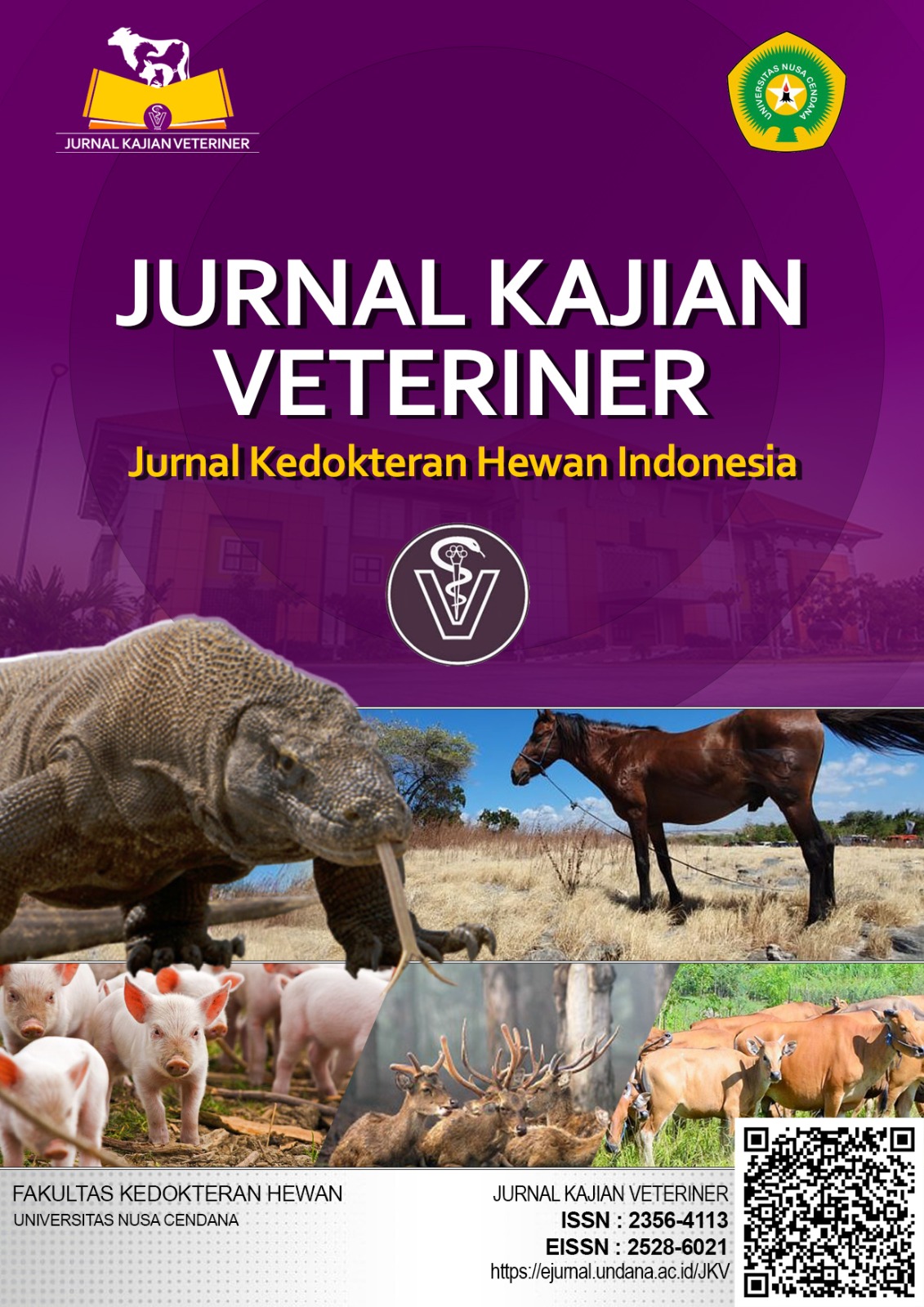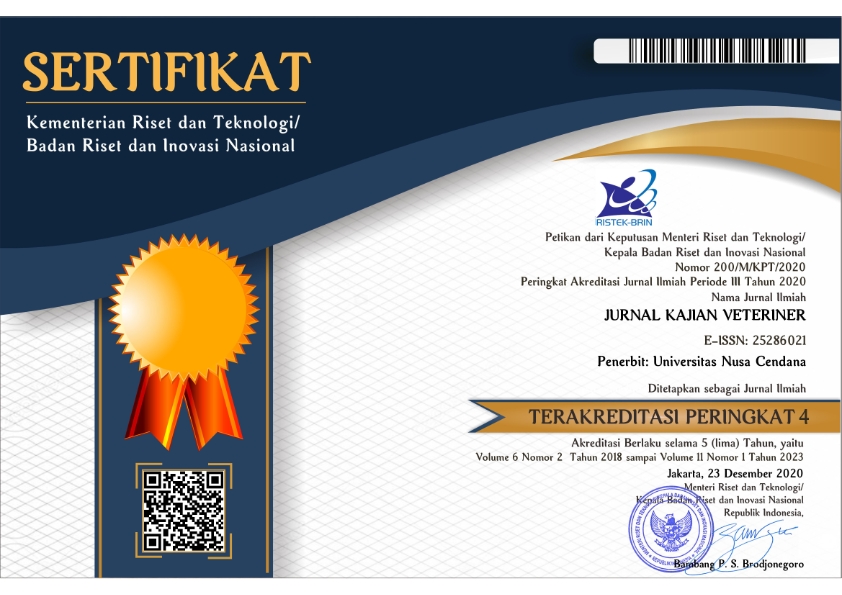Analisis Fisikokimia dan Aktivitas Antibakteri Madu Hutan Timor terhadap Methicillin-Resistant Staphylococcus aureus
Physicochemical Analysis and Antibacterial Activity of Timor Forest Honey against Methicillin-Resistant Staphylococcus aureus
Abstract
The emergence of antibiotic-resistant bacteria has become a global concern. One of the bacteria that is resistant to several types of antibiotics is Methicillin-Resistant Staphylococcus aureus (MRSA). Honey is known for its nutritional and antibacterial properties. The antibacterial activity of honey is due to several factors such as its physicochemical properties, H2O2, and phytochemicals compounds. Honey could be a promising alternative to overcome the problem of antibiotic resistance. The aim of this research was to determine the physicochemical, H2O2, Pinocembrin, Kaempferol and antimicrobial activity of Timor Forest honey. A total of 7 Timor Forest honey was analyzed to determine water content, water activity, pH, H2O2, Pinocembrin, Kaempferol and antibacterial activity. Moisture content, water activity, and pH were measured using a refractometer, aw-meter, and pH meter, respectively. Hydrogen peroxide content was measured using peroxide strip test. Pinocembrin and Kaempferol contents were measured using HPLC-DAD. The analysis showed that the water content, water activity and pH of Timor Forest honey were 17.52±3.31%, 0.6±0.01, 4.18±0.32, respectively. The content of H2O2, Pinocembrin, and Kaempferol were 109.1±47.1 µmol/L, 2.2±1.9 mg/100 g, 1.7±0.7 mg/100 g, respectively. The antibacterial activity of Timor Forest honey against MRSA was tested using Kirby-Bauer disc diffusion method. Vancomycin was used as positive control. The inhibition zone of Timor Forest honey and vancomycin was not significantly different with an average of 13.93±0.23 mm for Timor Forest honey and 14.33±0.05 mm for vancomycin. Timor forest honey has good physicochemical properties with a relatively high content of Pinocembrin and Kaempferol and has antibacterial activity against MRSA.
Downloads
References
Afifurrahman, Samadin KH, Aziz S. 2014. Pola kepekaan bakteri Staphylococcus aureus terhadap antibiotik Vankomisin di RSUP Dr. Mohammad Hoesin Palembang. MKS. 46(4).
Allen KL, Molan PC, Reid GM. 1991. A survey of the antibacterial activity of some New Zealand honeys. J Pharm Pharmacol. 43(12):817–822. doi: 10.1111/j. 2042-7158.1991.tb03186.x.
Bereket W, Hemolatha K, Getenet B, Wondwossen T, Solomon A, Zeynudin A, Kannan S. 2012. Update on bacterial nosocomial infections. Eur Rev Med Pharmacol Sci. 16(9):1039-1044.
Bogdanov S. 2009. Harmonized methods of the international honey commission. http://www.ihc-platform. net/ihcmethods2009.pdf.
Bogdanov S. 2015. Determination of Pinocembrin in honey using HPLC. J Apic Res. 28:55-57. https://doi.org/10.1080/00218839.1989.11100821.
[BSN] Badan Standarisasi Nasional. 2018. Standar Nasional Indonesia (SNI) 8664:2018 madu. Jakarta (ID): BSN.
Cavia MM, Fernández-Muiño MA, Huidobro JF, Sancho MT. 2004. Correlation between moisture and water activity of honeys harvested in different years. J Food Sci. 69:368–370.https://doi.org/10.1111/j.1365-2621.2004.tb10699.x
Chen C. 2019. Relationship between water activity and moisture content in floral honey. Foods. 8(30). doi:10.3390/foods8010030.
Cheung Y, Meenu M, Yu X, Xu B. 2019. Phenolic acids and flavonoids profiles of commercial honey from different floral sources and geographic sources. Int J Food Prop. 22(1):290-308. doi: https://doi.org/10.1080/10942912.2019.15 79835
Chirife J, Zamora MC, Aldo M. 2006. The correlation between water activity and % moisture in honey : fundamental aspects and application to Argentine honeys. J Food Eng. 72(3). doi: 10.1016/j.jfoodeng.2004.12.009.
[CLSI] Clinical and Laboratory Standards Institute. 2020. M100 – Performance Standards for Antimicrobial Susceptibility Testing. Ed ke–30. West Valley: CLSI.
[CAC] Codex Alimentarius Commission. 2022. Standard for honey. www.cod exalimentarius.org.
De Sousa JMB, De Souza EL, Marques G, Benassi MDT, Gullon B, Pintado MM, Magnani M. 2016. Sugar profile, physicochemical and sensory aspects of monofloral honeys produced by different stingless bee species in Brazilian semi-arid region. LWT. 65:645-651. doi: http://dx.doi.org/10.1016/j.lwt. 2015.08.058.
Huidobro JF, Santana FJ, Sanchez MP. 1995. Diastase, Invertase And B-Glucosidase Activities In Fresh Honey From North-West Spain. J Apic Res. 34(1). doi:10.1080/00218839.1995.11100884
Istasse T, Jacquet N, Berchem T, Haubruge E, Nguyen BK, Richel A. 2016. Extraction of honey polyphenols: method development and evidence of cis isomerization. Anal Chem Insights. 2016:11 49-57. doi:10.4137/ACI.S39739.
Kerkvliet JD. 1996. Screening method for the determination of peroxide acumulation in honey and relation with HMF content. J Apic Res. 35. doi: https://doi.org/10. 1080/00218839.1996.11100920.
Kwakman PHS, Zaat SAJ. 2012. Antibacterial components of honey. IUBMB Life.
64(1):48-55. doi: 10.1002/iub.578.
Li XM, Luo XG, Si CL, Wang N, Zhou H, He JF, Zhang TC. 2015. Antibacterial active compounds from Hypericum ascyron L. induce bacterial cell death through apoptosis pathway. Eur J Med Chem. 96:436–444.
Liu MH, Otsuka N, Noyori K, Shiota S, Ogawa W, Kuroda T, Hatano T, Tsuchiya T. 2009. Synergistic effect of Kaempferol glycosides purified from Laurus nobilis and fluoroquinolones on methicillin-resistant Staphylococcus aureus. Biol Pharm Bull. 32(3):489-492.
Misiak IJ, Gruyaert S, Poliwoda A, Kafarski P. 2017. Chemical profiling of polyfloral Belgian honey: ellagic acid and Pinocembrin as antioxidants and chemical marker. J chem. 2017(5393158). doi: https://doi.org/10.1155/2017/
5393158.
Molan PC. 1992. The antibacterial activity of honey 1, the nature of the antibacterial activity. Bee World. 73: 5-28.
Newman DJ, Cragg GM, Snader KM. 2000. The influence of natural products upon drug discovery. Nat Prod Res. 17(3):215–234. doi: 10.1039/a902202c.
Nuriman, Saputri NA, Pathiassana MT, Gaibi N, Lestian, Septiani AD, Pathiussina RT. 2021. Analisis pengaruh suhu terhadap warna, densitas, dan viskositas madu hutan lebah Apis dorsata dari Kecamatan Lunyuk, Sumbawa. J Pengolahan Pangan. 8(1). doi: https://doi.org/10.31970/pangan.v8i1.79.
Olaitan PB, Adeleke OE, Ola IO. 2007. Honey: a reservoir for microorganisms and an inhibitory agent for microbes. Afr Health Sci. 7(3):59-165. doi:10.5555/ afhs. 2007.7.3.159.
Panjaitan RA, Darmawati S, Prastiyanto ME. 2018. Aktivitas antibakteri madu terhadap bakteri multidrug resistant Salmonella typhi dan methicillin-resistant Staphylococcus aureus. Seminar Nasional Edusaintek FMIPA UNIMUS 2018. https://jurnal.unimus.ac.id/index.php/psn12012010/article/view/4240/3934.
Pribadi A, Wiratmoko ME. 2019. Karakteristik madu lebah hutan (Apis dorsata) dari berbagai bioregion di Riau. 37(3):185-200. doi: 10.20886/jphh.2019.37.3.185-200.
Ramadhan R, Hasballah K, Suryawati S, Mulia VD. 2022. Daya Hambat Madu Seulawah terhadap methicillin resistant Staphylococcus aureus (MRSA). Bioleuser. 6(3):1-4. https://jurnal.usk.ac.id/bioleuser/article/view/30484.
Rani GN, Budumuru R, Bandaru NR. 2017. Antimicrobial activity of honey with special reference to methicillin resistant Staphylococcus aureus (MRSA) and methicillin sensitive Staphylococcus aureus (MSSA). J Clin Diagn Res. 11(8). doi: 10.7860/JCDR/2017/30085.10347.
Salosso Y. 2019. The potential of honey (Apis spp.) from Timor Island as antibacterial against pathogenic bacteria in fish culture. IAJ. [diakses 2022 Mar 22];14(2):63-68. http://ejournal-balitbang.kkp.go.id/index.php/iaj.
Snowdon JA, Cliver DO. 1996. Microorganisms in honey. Int J Food Microbiol. 31: 1–26.
Strelec I, Crevar B, Kovac T, Billi Rajs B, Primorac LJ, Flanjak I. 2018. Glucose oxidase activity and hydrogen peroxide accumulation in Croatian honeys. Croat J Food Sci Technol. 10(1):33-41. doi: https://doi.org/10.17508/ CJFST. 2018. 10.1.06.
[USDA] United State Departement of Agriculture. 2011. USDA Database for the flavonoid content of selected foods. http://www.ars.usda.gov/nutrientdata.
White JW, Subers MH. 1963. Studies on honey inhibine 2 : a chemical assay. J Apic Res. 2(2):93-100.
Copyright (c) 2025 JURNAL KAJIAN VETERINER

This work is licensed under a Creative Commons Attribution-NonCommercial-NoDerivatives 4.0 International License.

 Fajar Okta Undari(1*)
Fajar Okta Undari(1*)








.png)


